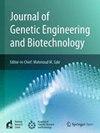Identification of high-risk signatures and therapeutic targets through molecular characterization and immune profiling of TP53-mutant breast cancer
IF 2.8
Q3 Biochemistry, Genetics and Molecular Biology
Journal of Genetic Engineering and Biotechnology
Pub Date : 2025-09-30
DOI:10.1016/j.jgeb.2025.100574
引用次数: 0
Abstract
Background
TP53 mutations are commonly observed in aggressive subtypes of breast cancer, influencing the tumor microenvironment (TME) and patient prognosis. In this study, we developed a prognostic gene-based risk model to stratify TP53-mutant breast cancer patients and explore potential therapeutic targets.
Methods
We performed comprehensive bioinformatics analyses using TCGA and METABRIC datasets to identify key prognostic genes in TP53-mutant breast cancer. Differential expression and Gene Set Enrichment Analysis (GSEA) revealed dysregulated pathways, while protein–protein interaction (PPI) networks highlighted functional hubs. Survival analysis, followed by univariate Cox regression, LASSO, and multivariate regression, led to the construction of a robust gene-based risk model. Immune landscape profiling was conducted to evaluate tumor microenvironment characteristics. Finally, drug sensitivity analysis and molecular docking were used to identify potential therapeutic agents targeting high-risk patients.
Results
TP53 mutations were present in ∼ 35 % of patients and associated with significant transcriptomic alterations. A total of 666 genes were consistently dysregulated, including 333 upregulated (such as A2ML1, CA9, VGLL1, PSAT1) and 333 downregulated (such as AGR3, TFF1, ESR1, CPB1) in TP53 mutated breast cancer patients. GSEA revealed that the cell cycle, DNA replication, and metabolic pathways in in TP53 mutated breast cancer patients. Protein–protein interaction (PPI) network analysis of these genes revealed tightly connected modules related to mitotic regulation and immune signaling, underscoring key functional hubs in TP53-mutant tumors. A four-gene prognostic model (FGFR4, S100P, ADM, CTSC) stratified TP53-mutant patients into high- and low-risk groups with distinct survival outcomes and immune profiles. High-risk patients exhibited a suppressed immune landscape, characterized by lower immune and stromal cell infiltration and higher tumor purity. Drug sensitivity analysis and molecular docking revealed several compounds, including Lapatinib, Docetaxel, and Trametinib, with strong binding affinities to key model genes. These drugs demonstrated potential efficacy in high-expression cells, suggesting their viability as targeted therapies.
Conclusion
Our findings underscore the prognostic value of the identified genes and the immunosuppressive TME in TP53-mutant breast cancer. The identification of drug candidates with strong binding affinities to key proteins provides promising avenues for targeted therapy in this high-risk patient population.
通过tp53突变型乳腺癌的分子特征和免疫分析鉴定高危特征和治疗靶点
背景tp53突变常见于侵袭性乳腺癌亚型,影响肿瘤微环境(TME)和患者预后。在这项研究中,我们建立了一个基于预后基因的风险模型来对tp53突变的乳腺癌患者进行分层,并探索潜在的治疗靶点。方法采用TCGA和METABRIC数据集进行综合生物信息学分析,确定tp53突变乳腺癌的关键预后基因。差异表达和基因集富集分析(GSEA)揭示了失调的途径,而蛋白质相互作用(PPI)网络突出了功能枢纽。生存分析,然后是单变量Cox回归、LASSO和多变量回归,构建了一个强大的基于基因的风险模型。采用免疫景观分析方法评价肿瘤微环境特征。最后,通过药物敏感性分析和分子对接,确定针对高危患者的潜在治疗药物。结果stp53突变存在于约35%的患者中,并与显著的转录组改变相关。共有666个基因持续失调,其中在TP53突变乳腺癌患者中有333个基因上调(如A2ML1、CA9、VGLL1、PSAT1), 333个基因下调(如AGR3、TFF1、ESR1、CPB1)。GSEA揭示了TP53突变乳腺癌患者的细胞周期、DNA复制和代谢途径。这些基因的蛋白-蛋白相互作用(PPI)网络分析揭示了与有丝分裂调节和免疫信号相关的紧密连接的模块,强调了tp53突变肿瘤的关键功能枢纽。四基因预后模型(FGFR4, S100P, ADM, CTSC)将tp53突变患者分为高风险和低风险组,具有不同的生存结果和免疫特征。高危患者表现为免疫抑制,免疫和基质细胞浸润较低,肿瘤纯度较高。药物敏感性分析和分子对接显示,包括拉帕替尼、多西他赛和曲美替尼在内的几种化合物与关键模型基因具有很强的结合亲和力。这些药物在高表达细胞中显示出潜在的疗效,表明它们作为靶向治疗的可行性。结论我们的研究结果强调了鉴定的基因和免疫抑制TME在tp53突变乳腺癌中的预后价值。与关键蛋白具有强结合亲和力的候选药物的鉴定为这一高危患者群体的靶向治疗提供了有希望的途径。
本文章由计算机程序翻译,如有差异,请以英文原文为准。
求助全文
约1分钟内获得全文
求助全文
来源期刊

Journal of Genetic Engineering and Biotechnology
Biochemistry, Genetics and Molecular Biology-Biotechnology
CiteScore
5.70
自引率
5.70%
发文量
159
审稿时长
16 weeks
期刊介绍:
Journal of genetic engineering and biotechnology is devoted to rapid publication of full-length research papers that leads to significant contribution in advancing knowledge in genetic engineering and biotechnology and provide novel perspectives in this research area. JGEB includes all major themes related to genetic engineering and recombinant DNA. The area of interest of JGEB includes but not restricted to: •Plant genetics •Animal genetics •Bacterial enzymes •Agricultural Biotechnology, •Biochemistry, •Biophysics, •Bioinformatics, •Environmental Biotechnology, •Industrial Biotechnology, •Microbial biotechnology, •Medical Biotechnology, •Bioenergy, Biosafety, •Biosecurity, •Bioethics, •GMOS, •Genomic, •Proteomic JGEB accepts
 求助内容:
求助内容: 应助结果提醒方式:
应助结果提醒方式:


